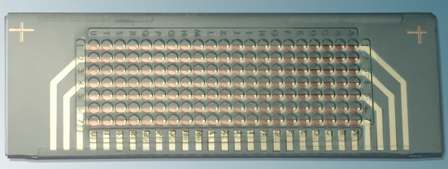| Laboratory systems | |
BIOIDENT unveils lab-on-a-chip prototype with integrated optical readout7 December 2006 Menlo park, Calif. USA. BIOIDENT Technologies Inc., a subsidiary of Austrian-based NANOIDENT Technologies AG, has unveiled a lab-on-a-chip prototype with a fully integrated opto-electronic readout system. The PhotonicLab platform is a cost-effective disposable lab-on-a-chip system that eliminates the need for expensive, bulky readout systems and provides immediate test results with significant cost savings. The prototype consists of a 1" x 3" nanotiter plate — a type of lab-on-a-chip device with multiple wells that can hold testing agents to perform laboratory functions. The nanotiter plate includes a fully integrated photodetector array based on printed semiconductor technology with a single pixel under each well. This array converts light into electrical signals, enabling analysis on multiple agents simultaneously and in real-time.
There is also no longer a need for high precision translational stages which are common among microplate and biochip readers. By placing the detector directly beneath the sample, the relative motion of the sample and detector are unnecessary. BIOIDENT’s printing process can be used on other lab-on-a-chip systems, including microfluidics, opening up new opportunities and applications for real-time analysis of chemical and biological substances. “With this prototype, BIOIDENT takes a significant leap forward in the industry to make the vision of lab-on-a-chip systems a reality,” said Dr. Wasiq Bokhari, CEO for BIOIDENT Technologies. “Working with our partners, we look forward to delivering breakthrough point of use tests for water and food analysis, chemical and biological agent detection and in-vitro diagnostics.” BIOIDENT is able to deliver this revolutionary prototype by leveraging its own PhotonicLab Platform, which uses organic semiconductor based technology to print light emitting and detecting capabilities directly on to any surface, including glass, enabling on-chip analysis and diagnostics. In addition, the company uses established testing protocols to deliver real-time and in-situ multi-parameter detection capabilities for all categories of chemical and biological analytes. The nanotiter plate for the prototype was provided by Microfluidic ChipShop GmbH in Jena, Germany.
|
